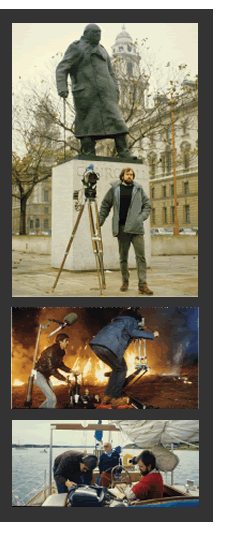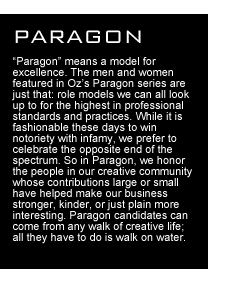| |


|
When he’s not traveling to exotic locales spearheading his latest project, Bill VanDerKloot, founder and president of VanDerKloot Film & Television, Magick Lantern, and Little Mammoth Media, calls his studio at 750 Ralph McGill, Atlanta, GA home. Amid the palm trees that greet visitors in the front atrium, and the daily bustling of this spacious and comfortable post-production house, resides a tireless and invigorated VanDerKloot, always ready to embark on the next challenge. His is a story of opting out of corporate America, following his cinematic dreams, and emerging as a leader in transforming Southern filmmaking.
Tinker, Tailor, Soldier, Spy
When a young Bill VanDerKloot decided to leave his Chappaqua, New York home for a taste of the South, he was accepted and enrolled in the ambitious Georgia Tech Five-Year Program with the opportunity to earn two degrees: one in Engineering from Georgia Tech, and a Bachelor of Arts from the University of Georgia. VanDerKloot kept his college plate full with courses in Biology, summer engineering internships with elite Fortune 500 companies, and as president of the Cinema Society. Although spending his free time writing movie reviews for the school newspaper and making Super-8 movies, everyone discouraged him from pursuing his filmmaking dreams. “All the authority figures in my life suggested that going into the film business was probably not a good idea.” They told him, “You need to work for a big corporation and do film on the side.” After attending a talk by Eugene Odum, the “Father of Environmental Biology” at UGA, VanDerKloot momentarily lost sight of his filmmaking dreams. “I was so impressed and I said, ‘This is something I want to do,’ and so I changed my major to Environmental Biology and
I minored in Physics.” VanDerKloot changed his mind after graduating from college. “I was offered an engineering job working at a Fortune 500 company, and I had to make a decision about what I wanted to do and I turned it down and went to New York.” He spent the next year like any good apprentice in the business, sleeping on friends’ couches and volunteering at any production company that could teach him the ropes. With newfound confidence and a healthy dose of twenty-something naivety, VanDerKloot “thought, well, you know, I can do as well as any of these people I’m working for. I’ll just start my own company!” The next decision he had to make was... location, location, location! VanDerKloot returned to Atlanta. “I had a lot of friends down here from school. I really liked Atlanta and I felt it was a great town to start a business in because it wasn’t as saturated as New York and set in its ways; it felt more like a frontier.”
An Electric Typewriter and a Movieola
The first step was to get the word out to the community that VanDerKloot Film & Television had arrived and was open for business. He took out an ad in the Atlanta Yellow Pages under “Production Companies” and while the rest of Atlanta sped by, the seeds of contemporary Southern filmmaking were spreading roots in a tiny one-bedroom apartment on 7th Street in Midtown. His desk was set up in the living room, where he also kept his one luxury item. “I splurged on an IBM Electric typewriter because it was great for writing grant and film proposals. Then I got a Moviola flatbed editing console and put that in the only other room, in the kitchen area.” Although running a one-man operation, VanDerKloot recruited friends and freelancers to assist in the daily operations of his home-grown production work, many of whom he still works with today. His pitch for luring friends over to the VanDerKloot enterprise? “I think they liked taking a chance along with me.”
VanDerKloot’s first major success came in 1979 at the London International Film Festival where he won an award for his music documentary, “It’s a Mean, Old World,” a collaborative project with John English and Rob Williams, both professors at UGA. True to his eclectic tastes, excited by his first award, and eager to start adding clients to his rooster, VanDerKloot began work with Georgia IronWorks in Augusta, creating industrial films about iron pouring. He also took on projects from the Newsweek Broadcasting Service, providing mini docu-profiles on interesting and newsworthy people from the Southeast.
Turning Film and Video into Magick
In 1980 VanDerKloot was ready to move his office into the present-day location of Magick Lantern in Midtown, Atlanta. Although he began by renting only one office, he would soon become the owner of the whole building. VanDerKloot and his team were shooting and editing on film, “but as film editing transitioned into video-tape editing, we found we were spending more and more money and time sometimes living at one of the two post-production houses, either Crawford or VTA.” Video tape equipment was very expensive, but with the world’s largest laser disk interactive educational project on the books, VanDerKloot made an executive decision to construct a video editing room for his company’s own use. Soon, colleagues were asking him for permission to use the editing facilities. VanDerKloot was thrilled not only to be able to help his fellow filmmakers, but also to have found a way to make the studio pay for itself. To help handle the traffic of people using the facility, he added “customer service and booking and suddenly we decided we’d either got to do this, or not do it, and so we decided to go ahead and open Magick Lantern as a full-blown post production facility” in 1990. The company has continued to grow from there. “It’s almost the tail wagging the dog, now,” VanDerKloot says, “The majority of the full-time employees now work for Magick Lantern.”
VanDerKloot Film & Television’s sister company, Magick Lantern, opened doors with an ambitious and socially conscious mission: to create quality media that makes a difference. “The whole idea of making a difference is doing good work, keeping people happy, and creating a creative environment that our clients thrive in, but also where everyone who works here thrives in. So it’s more like a family atmosphere.”
VanDerKloot also makes sure to give back to his community by providing pro bono services to local institutions such as The Carter Center and Habitat for Humanity, as well as work on the first video for Atlanta’s proposed Beltline.
A Big Adventure
With a career on the rise and a budding family of his own, VanDerKloot decided he also wanted to make a difference in the world of children’s programming. While watching videos with his children, he was disappointed by the lack of sophistication and amateur quality of most movies, “It seemed as if very little effort was put into the research or production of those products,” VanDerKloot remembers. Having all the necessary skills and equipment, as well as an interest and curiosity about the world as seen through the eyes of children, VanDerKloot founded Little Mammoth Media, a company focused on providing quality entertainment for children and their families. VanDerKloot’s mission was clear, “Don’t talk down to kids. Don’t assume they’re silly or stupid, because they’re not. Just because they can’t express themselves doesn’t mean they can’t absorb the information.” At the heart of Little Mammoth is the Big Adventure Series, a collection of 16 videos that focus on educating children about different aspects of the world, from how USA Today works in “The Big Newspaper,” to the inner workings of the Coast Guard, in the newest addition, “The Big Rescue.” Little Mammoth’s work has been applauded by critics, parents and children alike, garnering dozens of awards and accolades from Parent’s Choice, Kids First!, Video Librarian, CINE and the International Monitor Awards.
To Infinity . . . and Beyond!
Despite his industry success and diversified body of work, VanDerKloot remains energetic and excited for the future, taking on ever more interesting projects. The summer of 2006 was the busiest ever for Magick Lantern, Little Mammoth and VanDerKloot. “My favorite project is always the one I’m currently working on,” he says. 2007 already has a busy production schedule. “My love is in documentaries and I’m working on one right now. It’s a WWII history story, dealing with the ‘Fairy Command,’ where a number of American civilians were flying bombers across the North Atlantic to England before the United States got in the war and how dangerous it was.” VanDerKloot got a head start by interviewing survivors on location in Canada and Massachusetts. For Little Mammoth, next year boasts three new Big Adventure videos, all of which are already in active pre-production.
As for predictions on the future, he anticipates many challenges facing small businesses, from changes in the state of the economy to advances in technology. “How is technology going to help or hurt me?” he wonders. “We see a future in BlueRay, Google Video Store and video on demand deals around the world. In five years, packaged media will be out of date. As soon as bandwidth increases to the point where it’s convenient for someone to download a full resolution video, they’ll do that. It’s going to take awhile for people to get used to that and for the technology to catch up,” he predicts. VanDerKloot also believes that HiDef is quickly becoming the new standard. “This year we finally bought a Sony F900 HD camera. We added another Avid Adrenaline HD Suite. I think HD is ready for prime time.”
Whatever the future may bring for Bill VanDerKloot and his enterprise, it’s clear he is a unique and ambitious leader pioneering the film industry in the Southeast. With his combination of entrepreneurial spirit, good nature and commitment to the community, everything he touches turns to, well...Magick. |
|